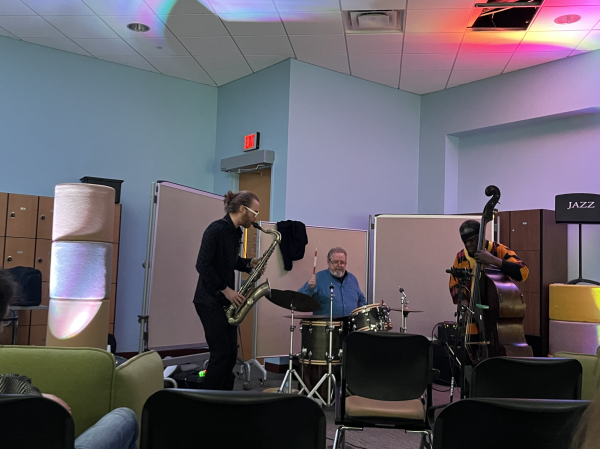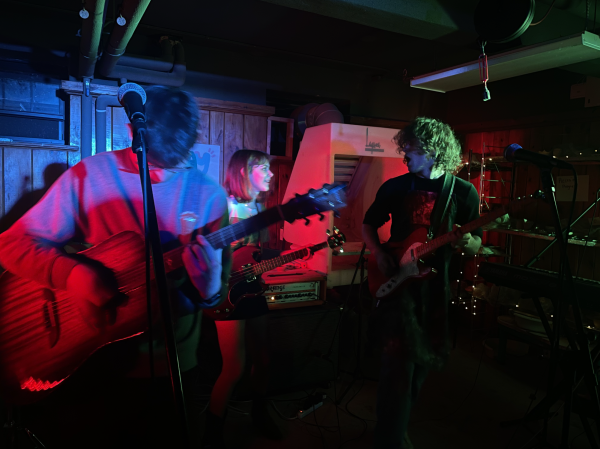Haudenosaunee Speakers Series: Doug George-Kanentiio
On Sept. 29, one day before Canada’s National Day for Truth and Reconciliation, Doug George-Kanentiio came to Colgate to share his story. He is an outspoken survivor of the infamous Mohawk Institute Residential School in Brantford, Ontario, Canada, where over 100 students are said to have been abducted from their homes, abused and killed.
Doug George-Kanentiio of the Mohawk Bear Clan is an award-winning freelance Native American author and activist. He has written in several newspapers and produced books such as Iroquois Culture & Commentary, Iroquois on Fire, and Skywoman: Legends of the Iroquois, alongside his late wife, Joanne Shenandoah. He also serves as the Vice President of the Hiawatha Institute for Indigenous Knowledge.
Chris Vecsey, Harry Emerson Fosdick Professor of the Humanities and Native American Studies in the Department of Religion, introduced George-Kanentiio as part of the Haudenosaunee Speaker Series, which the Native American Studies department sponsored. Vecsey has known George-Kanentiio and the late Shenandoah for almost 30 years and spoke fondly about his relationship with them, describing him as “an intellectual and a great writer.” He elucidated that the idea for the Speaker Series came to fruition through many of their mutual unions.
“I had this idea in the spring that I would like to have a whole series of talks by Haudenosaunee people, letting them talk to us,” Vecsey said.
He went on to reach out to Haudenosaunee people he knew, asking if they would be interested in speaking about their experiences, and a bunch of them enthusiastically agreed. As for the topics discussed, Vecsey proposed four culturally central topics.
“Food, language, art, education, I just thought these are really important aspects of life, and we’re going to have Haudenosaunee talk about them,” said Vecsey.
Sophomore Georgette Manos spoke of her experience in Vecsey’s course on the Haudenosaunee people. Manos expounded how it expanded her knowledge of Colgate’s founding and the history of George-Kanentiio’s people.
“By taking Professor Vescey’s Haudenosaunee class, I have had the opportunity to explore a lot about the land Colgate rests on as well as the local history and culture of this region that is often forgotten and not taught,” said George-Kanentiio. “Doug George-Kanentiio’s lecture is just one of the many amazing speakers the Haudenosaunee Speaker series is bringing to Colgate, exploring current issues Haudenosaunee people care about today for their communities and in the world.”
George-Kanentiio wore his ceremonial headdress when he was greeted at Lawrence Hall 105 by a bustling crowd of students and teachers, who outnumbered the chairs available in the room.
George-Kanentiio began his lecture by delving into his experience at Residential School. He was taken from his home in the Akwesasne Mohawk Territory at age 11. He was sent to the Mohawk Institute Residential School, known for being one of the worst Residential Schools, where he would remain for a dreadful year and a half. To give the audience a better idea of the severity of the charge, he informed us that parents could be arrested if they protested.
So, he and a couple of others boarded a train; when they arrived at the destination, they remained with the station master for numerous hours, until three in the morning, when, finally, a person came to take them to the school. He then spoke of the horrible living conditions he encountered:
“By keeping us hungry, they kept us under control. We really had three major emotions that went through us each day: fear, [hunger and anger]. Most of the abuse came from older boys exercising their anger and frustration on younger boys, and sexual abuse [perpetrated by the older boys] would come from the desire for affection […] this would happen on a daily bases,” said George-Kanentiio. “[Security] would visit them at night and go to the younger boys especially, and do anything they wanted to any boy they identified as prey, but [his friend, Joey] avoided that because he was [protected by] us. The only way to survive an institution like that was to be actively rebellious […] so you were not labeled as easy prey, but there would also be consequences for that.”
At that time, George-Kanentiio explained, there were 200 students of mixed native ancestry. Groups would form around different ethnicities, which sometimes came into conflict. His group consisted mainly of Mohawks, and he detailed that he was not invulnerable to the circumstances: he engaged in criminal acts and bullied other students. His goal was that no one would identify him as a “prey.”
George-Kanentiio continued to describe a special relationship with the student named Joey:
“Joey ran whenever he faced trouble and found us, the Mohawks, who would defend him.”
Joey found a safer haven for some time, but after George-Kanentiio and his group were expelled for troublemaking and sent to foster homes, Joey was left alone and vulnerable, and could not endure the abuse without his friends to help. George-Kanentiio stated that with no one to turn to, how Joey fled from the institution an astonishing 500 kilometers, pursued by police, and made it all the way to Hamilton, Ontario, Canada, and was tragically hit by a train. Joey’s parents’ complaints finally led to the Mohawk school’s close in 1971.
First-year Marisa Zarcone, attending the event with her course, “The American School,” spoke about her experience at the lecture:
“I attended the event for my American School class, and I’m glad I did because these are often the stories that get overlooked when we learn about Native American history,” said Zarcone. “The experiences of survivors like George-Kanentiio are important and necessary to hear about as we reckon with the abuses and mistreatment of Indigenous children faced in these boarding schools.”
The bounds and depth of information were too great to fit entirely into a single event. Still, George-Kanentiio left us off with the reverberant message of the intergenerational damage caused by the systematic oppression of Native Americans by the Residential Schools and how his cause is still fighting to expose hidden records from the groups involved, bring the perpetrators to justice, hold the institutions that enabled them criminally liable, obtain reparations and continue the efforts of locating and excavating the bodies of students who were killed and buried on the campuses of these residential schools.

Robert "Jerry" Pfeifer is a junior from New Paltz, NY concentrating in political science. He has previously served as a staff writer for the Arts &...






